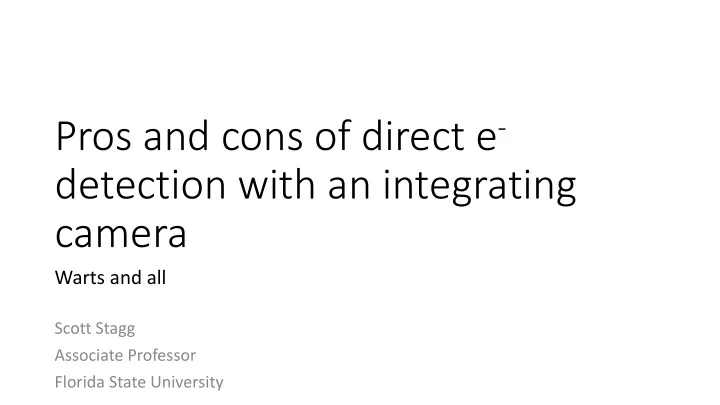

Pros and cons of direct e - detection with an integrating camera Warts and all Scott Stagg Associate Professor Florida State University
Outline • Comparison of integrating vs counting detectors • Potential advantages of integrating cameras • Importance of throughput • Our experiences with DE cameras • The DE64 • A fair comparison of detectors
Counting vs. integrating e - hits are ”counted” • e - detection results in a certain number of • Removes Landau noise due to e - • counts depositing different amounts of energy Frames are summed up • Counted frames sorted into bins then • whole set of frames summed McMullan et al., JSB, 2014
DQE comparison for various detectors • Due to reduction in Landau noise, DQE for counting is dramatically better than integrating Ruskin et al . , JSB, 2013
Other key differences between integrating and counting • 1 second exposure time for integrating vs 10 s exposure for K2 counting for the same dose • Gives the integrating mode potential for higher throughput • Much brighter beam used for integrating compared to counting • ~ 60 e-/Å 2 /s integrating • ~ 6 e-/Å 2 /s counting • So beam induced motion will be different for the two modes of data collection
Potential advantages of integrating • Potentially higher throughput • Depending on what is rate limiting step • Data collection dependent • This can be important because as a field, we’re throwing away up to 90% of our data • Potentially better beam induced motion • We have observed less motion than others have reported • This has not been systematically tested
Plots of spatial frequency vs. log(N) particles are linear Resolu'on)vs.)N)ptcls) Spa$al&Frequency&vs.&Log(Nptcls)& 16" 0.2" 0.18" 14" 0.16" Spa$al&Frequency&(1/Å)& 12" 0.14" Resolu'on)(Å)) 10" 0.12" 8" 0.1" 0.08" 6" 0.06" 4" 0.04" 2" 0.02" 0" 0" 100" 5100" 10100" 15100" 20100" 25100" 30100" 500" 5000" 50000" N)ptcls) N&ptcls&
ResLog slope and intercepts are indicators of quality of data/reconstruction average% 0.2% CTF%300%sig% Euler%50%% Euler%75%% 0.15% Spa$al&Frequency&(1/Å)& 0.1% 0.05% 0% !0.05% 1% 10% 100% 1000% 10000% N&Ptcls& Stagg et al. , JSB, 2014
Lower DQE at low frequency can be compensated by higher dose Grant et al. , eLife, 2015 Ruskin et al . , JSB, 2013
Low frequency contrast improves with higher dose 15 e - /Å 2 52 e - /Å 2 52 e - /Å 2 Aligned/summed Aligned/summed Aligned/compensated
Our experience with DE cameras
Successes 2.8 Å AAV 2.8 Å Human bocavirus Full length myosin filaments Spear et al., JSB, 2015 Mietzch et al., J. Virol, 2017 Hu et al. , Science Advances, 2016
A call for objectivity • Let us endeavor to not be victims of confirmation bias • A criticism on a recent grant application suggested essentially “you can’t do that without a K2”
Importance of achieving sufficient counts per frame Same mean Spot 4 Spot 8 1s exposure 4s exposure 32 fps 32 fps
Progress toward counting 80 s exposure 2560 frames 80 counted/summed frames 160 counted/summed frames
Counting on DE20 with Leginon • Frame rate increased by using only central 1/3 of pixels • Abandoned because insufficient area to do targeting and autofocusing in Leginon
DE64 at FSU • Installed in May 2017 • One week afterwards • Hose failure gave the camera a bath • Also killed the chiller for the Titan • After camera reinstalled • Shutter got stuck • Unsticking the shutter showered chip in dust • Factory serviced shutter and rinsed the chip in acetone • Working fine now • S#@t happens
DE64 technical specs • 6.5 um pixels (as compared to 5 um K2, or 14 um Falcon II) • Variable frame rate up to 45 fps for 8K x 8K images • This can be useful for accumulating sufficient counts per frame with different dose rates • 146 fps with 2x hardware binning • 4K x 4K counting mode
Modulation Transfer Function G. D. Boreman, Modulation Transfer Function in Optical and Electro-Optical Systems , SPIE Press, Bellingham, WA (2001).
DE64 e - detection performance Calculated using FindDQE from Grigorieff lab From Direct Electron
Results so far with the DE64 2688 ptcls 4.3 Å
80S ribosome with preferred orientation 5.4 Å resolution
Towards a fair comparison • The goal: compare reconstructions from same sample on same grid on different cameras • Determine resolution as function of time on the scope • Clearly on a per particle basis particles will be better with counting, but one can collect more particles per unit time with integrating • Endeavor to take sample preparation variability out of the equation • Collect on Apoferritin • High symmetry but hard to align • Samples prepared with Spotiton
First attempt at Apoferritin
Throughput • 1421 images in ~12 hours • 801,000 particles • ~8 TB of data • Did not get anywhere with reconstruction • There is some problem with the data • Thon rings are poor on carbon
Compared to good dataset
Tomography of lamella Imaging area of 2.8 um at Small cutout showing bilayer sampling of 3.4 Å/pix
Movie of lamella
Acknowledgements • AAV • Direct Electron • Benjamin Bammes • Alex Noble • Liang Jin • Jason Spear • Michael Spilman • Guiqing Hu • Reza Paraan • Michael Chapman Lab • Qing Xie • Nancy Meyer • Thomas Lerch • FIB/SEM • NRAMM • Bridget Carragher and Clint Potter • Alex Noble • Ash Raczkowski • Spotiton team Supported by: National Institutes of Health, FSU Developing scholar grant
Recommend
More recommend